Case Study Assignment: Nursing Informatics Practice Applications
VerifiedAdded on 2022/08/29
|9
|2116
|16
Case Study
AI Summary
This case study analyzes the application of nursing informatics in healthcare, focusing on the scenario of Mrs. Jones, an elderly patient, and Dr. Smith's interaction with the electronic health record (EHR) and clinical information system (CIS). The assignment explores the benefits and drawbacks of nursing informatics, including the importance of access to patient information and the reliability of technology. The case highlights the role of CIS in suggesting an MRI based on patient history and the potential ramifications when a physician cancels an alert. The study also discusses the impact of canceling alerts on patient safety and explores the advantages and disadvantages of electronic health records. The author includes a personal perspective on what to include in an EHR and describes workarounds used in their place of work, illustrating real-world challenges in implementing informatics effectively. The paper references relevant literature to support the arguments and findings.
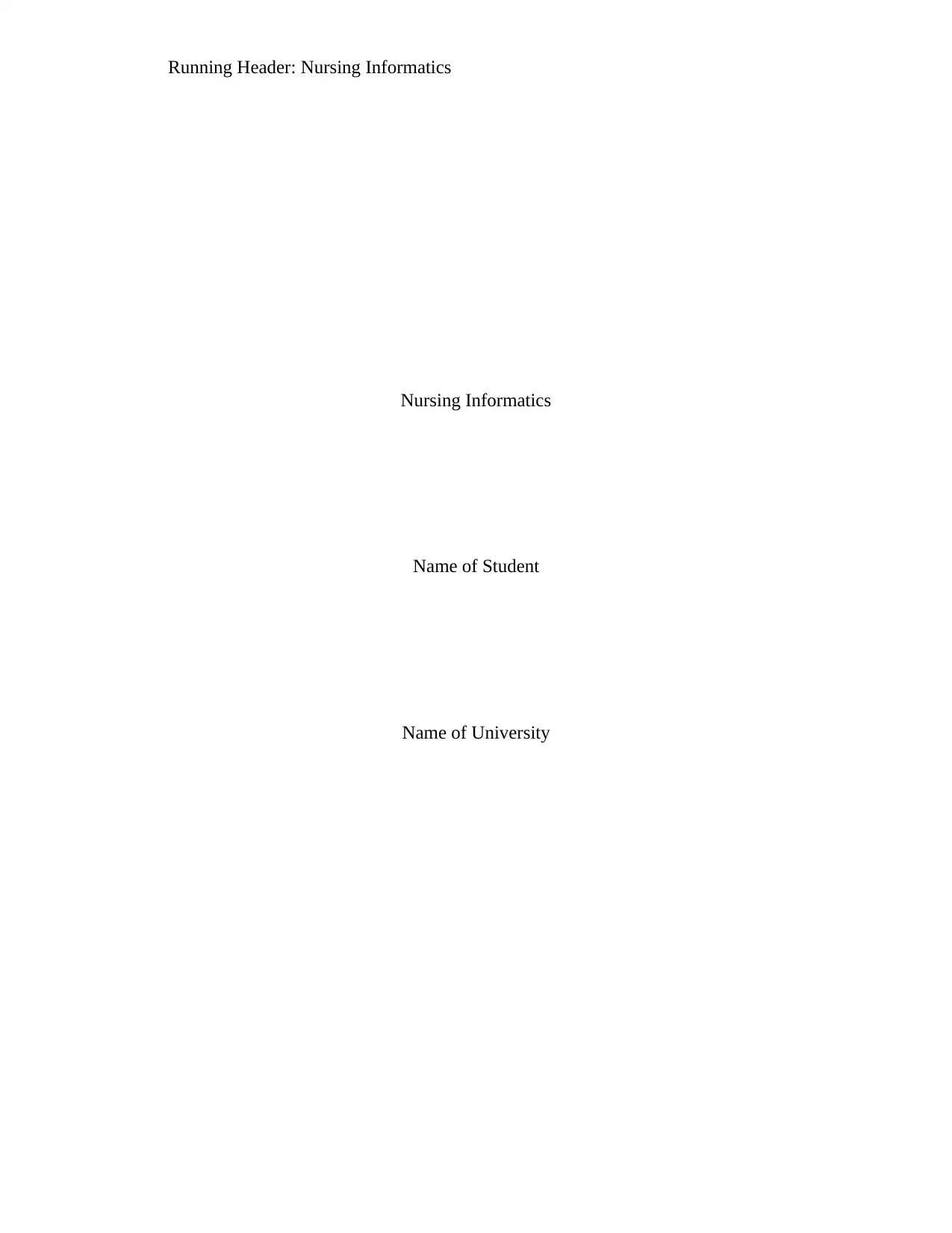
Running Header: Nursing Informatics
Nursing Informatics
Name of Student
Name of University
Nursing Informatics
Name of Student
Name of University
Paraphrase This Document
Need a fresh take? Get an instant paraphrase of this document with our AI Paraphraser
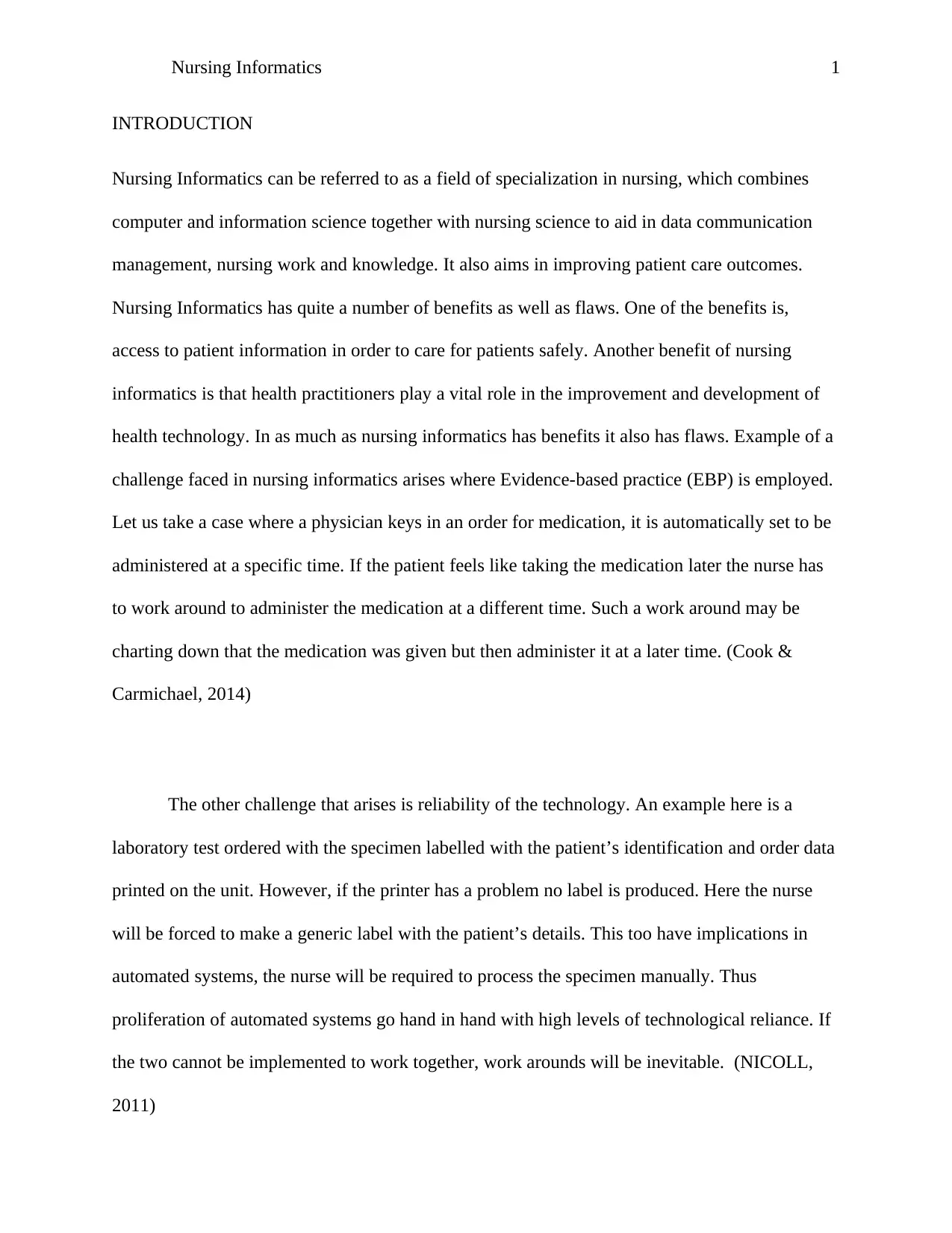
Nursing Informatics 1
INTRODUCTION
Nursing Informatics can be referred to as a field of specialization in nursing, which combines
computer and information science together with nursing science to aid in data communication
management, nursing work and knowledge. It also aims in improving patient care outcomes.
Nursing Informatics has quite a number of benefits as well as flaws. One of the benefits is,
access to patient information in order to care for patients safely. Another benefit of nursing
informatics is that health practitioners play a vital role in the improvement and development of
health technology. In as much as nursing informatics has benefits it also has flaws. Example of a
challenge faced in nursing informatics arises where Evidence-based practice (EBP) is employed.
Let us take a case where a physician keys in an order for medication, it is automatically set to be
administered at a specific time. If the patient feels like taking the medication later the nurse has
to work around to administer the medication at a different time. Such a work around may be
charting down that the medication was given but then administer it at a later time. (Cook &
Carmichael, 2014)
The other challenge that arises is reliability of the technology. An example here is a
laboratory test ordered with the specimen labelled with the patient’s identification and order data
printed on the unit. However, if the printer has a problem no label is produced. Here the nurse
will be forced to make a generic label with the patient’s details. This too have implications in
automated systems, the nurse will be required to process the specimen manually. Thus
proliferation of automated systems go hand in hand with high levels of technological reliance. If
the two cannot be implemented to work together, work arounds will be inevitable. (NICOLL,
2011)
INTRODUCTION
Nursing Informatics can be referred to as a field of specialization in nursing, which combines
computer and information science together with nursing science to aid in data communication
management, nursing work and knowledge. It also aims in improving patient care outcomes.
Nursing Informatics has quite a number of benefits as well as flaws. One of the benefits is,
access to patient information in order to care for patients safely. Another benefit of nursing
informatics is that health practitioners play a vital role in the improvement and development of
health technology. In as much as nursing informatics has benefits it also has flaws. Example of a
challenge faced in nursing informatics arises where Evidence-based practice (EBP) is employed.
Let us take a case where a physician keys in an order for medication, it is automatically set to be
administered at a specific time. If the patient feels like taking the medication later the nurse has
to work around to administer the medication at a different time. Such a work around may be
charting down that the medication was given but then administer it at a later time. (Cook &
Carmichael, 2014)
The other challenge that arises is reliability of the technology. An example here is a
laboratory test ordered with the specimen labelled with the patient’s identification and order data
printed on the unit. However, if the printer has a problem no label is produced. Here the nurse
will be forced to make a generic label with the patient’s details. This too have implications in
automated systems, the nurse will be required to process the specimen manually. Thus
proliferation of automated systems go hand in hand with high levels of technological reliance. If
the two cannot be implemented to work together, work arounds will be inevitable. (NICOLL,
2011)
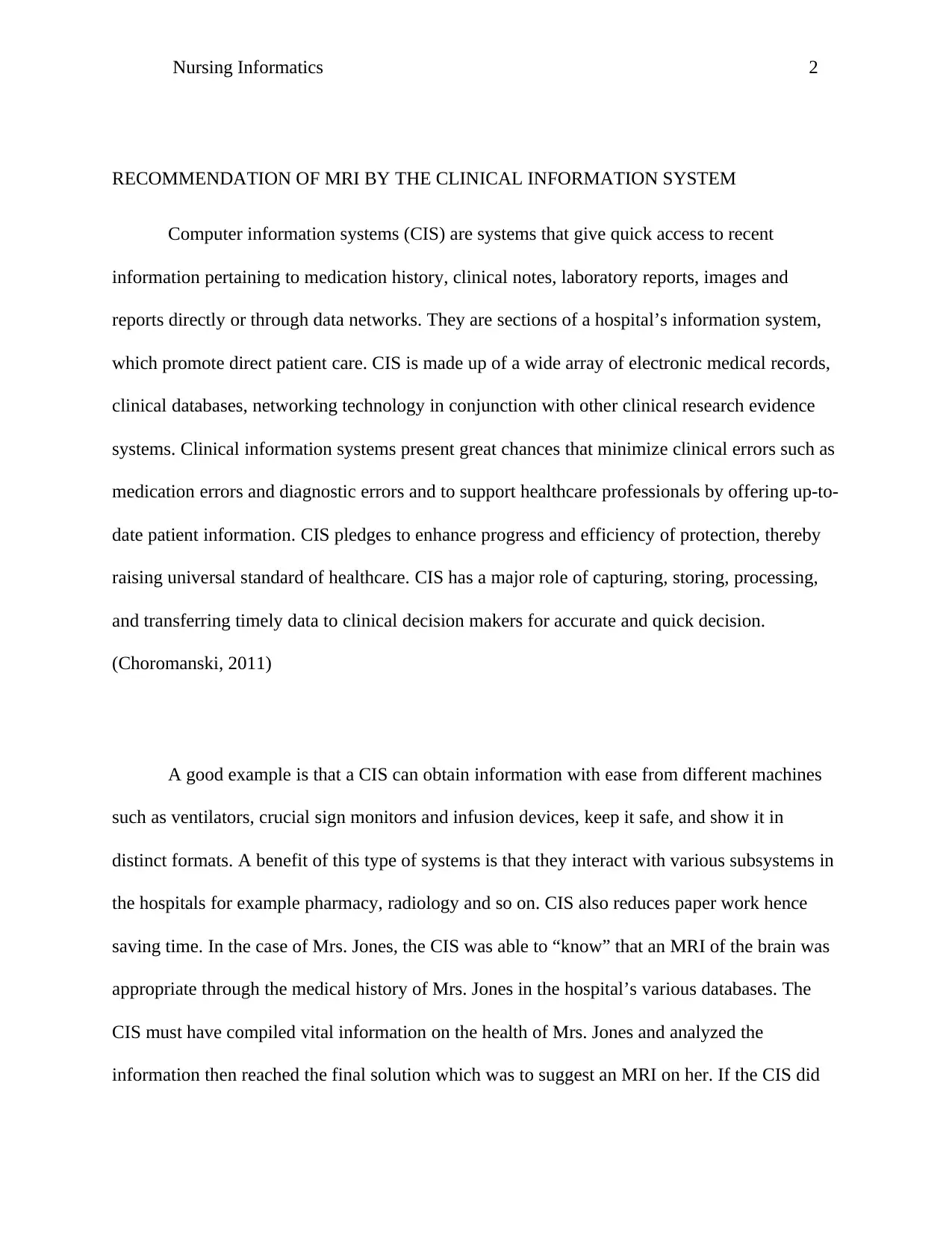
Nursing Informatics 2
RECOMMENDATION OF MRI BY THE CLINICAL INFORMATION SYSTEM
Computer information systems (CIS) are systems that give quick access to recent
information pertaining to medication history, clinical notes, laboratory reports, images and
reports directly or through data networks. They are sections of a hospital’s information system,
which promote direct patient care. CIS is made up of a wide array of electronic medical records,
clinical databases, networking technology in conjunction with other clinical research evidence
systems. Clinical information systems present great chances that minimize clinical errors such as
medication errors and diagnostic errors and to support healthcare professionals by offering up-to-
date patient information. CIS pledges to enhance progress and efficiency of protection, thereby
raising universal standard of healthcare. CIS has a major role of capturing, storing, processing,
and transferring timely data to clinical decision makers for accurate and quick decision.
(Choromanski, 2011)
A good example is that a CIS can obtain information with ease from different machines
such as ventilators, crucial sign monitors and infusion devices, keep it safe, and show it in
distinct formats. A benefit of this type of systems is that they interact with various subsystems in
the hospitals for example pharmacy, radiology and so on. CIS also reduces paper work hence
saving time. In the case of Mrs. Jones, the CIS was able to “know” that an MRI of the brain was
appropriate through the medical history of Mrs. Jones in the hospital’s various databases. The
CIS must have compiled vital information on the health of Mrs. Jones and analyzed the
information then reached the final solution which was to suggest an MRI on her. If the CIS did
RECOMMENDATION OF MRI BY THE CLINICAL INFORMATION SYSTEM
Computer information systems (CIS) are systems that give quick access to recent
information pertaining to medication history, clinical notes, laboratory reports, images and
reports directly or through data networks. They are sections of a hospital’s information system,
which promote direct patient care. CIS is made up of a wide array of electronic medical records,
clinical databases, networking technology in conjunction with other clinical research evidence
systems. Clinical information systems present great chances that minimize clinical errors such as
medication errors and diagnostic errors and to support healthcare professionals by offering up-to-
date patient information. CIS pledges to enhance progress and efficiency of protection, thereby
raising universal standard of healthcare. CIS has a major role of capturing, storing, processing,
and transferring timely data to clinical decision makers for accurate and quick decision.
(Choromanski, 2011)
A good example is that a CIS can obtain information with ease from different machines
such as ventilators, crucial sign monitors and infusion devices, keep it safe, and show it in
distinct formats. A benefit of this type of systems is that they interact with various subsystems in
the hospitals for example pharmacy, radiology and so on. CIS also reduces paper work hence
saving time. In the case of Mrs. Jones, the CIS was able to “know” that an MRI of the brain was
appropriate through the medical history of Mrs. Jones in the hospital’s various databases. The
CIS must have compiled vital information on the health of Mrs. Jones and analyzed the
information then reached the final solution which was to suggest an MRI on her. If the CIS did
⊘ This is a preview!⊘
Do you want full access?
Subscribe today to unlock all pages.

Trusted by 1+ million students worldwide
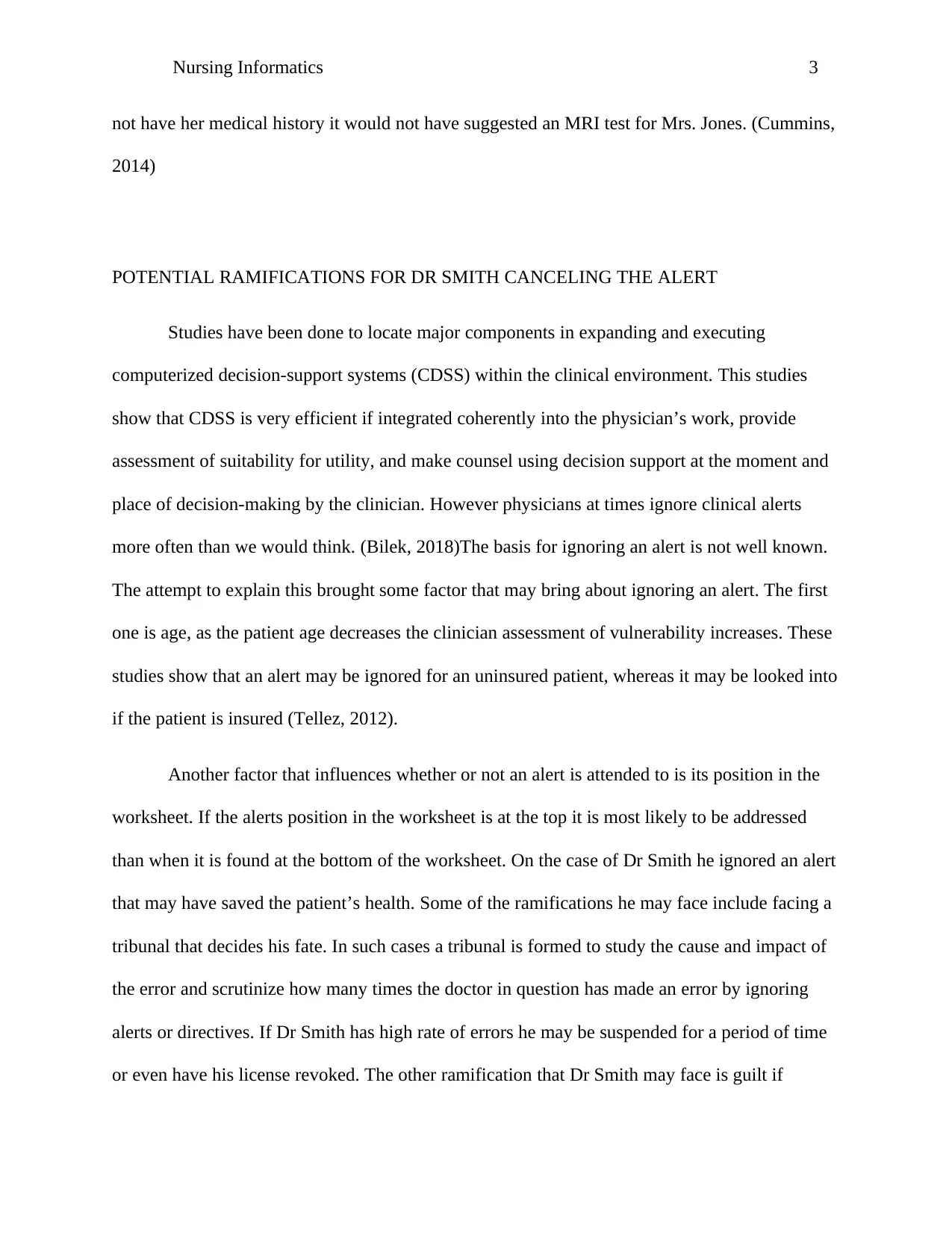
Nursing Informatics 3
not have her medical history it would not have suggested an MRI test for Mrs. Jones. (Cummins,
2014)
POTENTIAL RAMIFICATIONS FOR DR SMITH CANCELING THE ALERT
Studies have been done to locate major components in expanding and executing
computerized decision-support systems (CDSS) within the clinical environment. This studies
show that CDSS is very efficient if integrated coherently into the physician’s work, provide
assessment of suitability for utility, and make counsel using decision support at the moment and
place of decision-making by the clinician. However physicians at times ignore clinical alerts
more often than we would think. (Bilek, 2018)The basis for ignoring an alert is not well known.
The attempt to explain this brought some factor that may bring about ignoring an alert. The first
one is age, as the patient age decreases the clinician assessment of vulnerability increases. These
studies show that an alert may be ignored for an uninsured patient, whereas it may be looked into
if the patient is insured (Tellez, 2012).
Another factor that influences whether or not an alert is attended to is its position in the
worksheet. If the alerts position in the worksheet is at the top it is most likely to be addressed
than when it is found at the bottom of the worksheet. On the case of Dr Smith he ignored an alert
that may have saved the patient’s health. Some of the ramifications he may face include facing a
tribunal that decides his fate. In such cases a tribunal is formed to study the cause and impact of
the error and scrutinize how many times the doctor in question has made an error by ignoring
alerts or directives. If Dr Smith has high rate of errors he may be suspended for a period of time
or even have his license revoked. The other ramification that Dr Smith may face is guilt if
not have her medical history it would not have suggested an MRI test for Mrs. Jones. (Cummins,
2014)
POTENTIAL RAMIFICATIONS FOR DR SMITH CANCELING THE ALERT
Studies have been done to locate major components in expanding and executing
computerized decision-support systems (CDSS) within the clinical environment. This studies
show that CDSS is very efficient if integrated coherently into the physician’s work, provide
assessment of suitability for utility, and make counsel using decision support at the moment and
place of decision-making by the clinician. However physicians at times ignore clinical alerts
more often than we would think. (Bilek, 2018)The basis for ignoring an alert is not well known.
The attempt to explain this brought some factor that may bring about ignoring an alert. The first
one is age, as the patient age decreases the clinician assessment of vulnerability increases. These
studies show that an alert may be ignored for an uninsured patient, whereas it may be looked into
if the patient is insured (Tellez, 2012).
Another factor that influences whether or not an alert is attended to is its position in the
worksheet. If the alerts position in the worksheet is at the top it is most likely to be addressed
than when it is found at the bottom of the worksheet. On the case of Dr Smith he ignored an alert
that may have saved the patient’s health. Some of the ramifications he may face include facing a
tribunal that decides his fate. In such cases a tribunal is formed to study the cause and impact of
the error and scrutinize how many times the doctor in question has made an error by ignoring
alerts or directives. If Dr Smith has high rate of errors he may be suspended for a period of time
or even have his license revoked. The other ramification that Dr Smith may face is guilt if
Paraphrase This Document
Need a fresh take? Get an instant paraphrase of this document with our AI Paraphraser
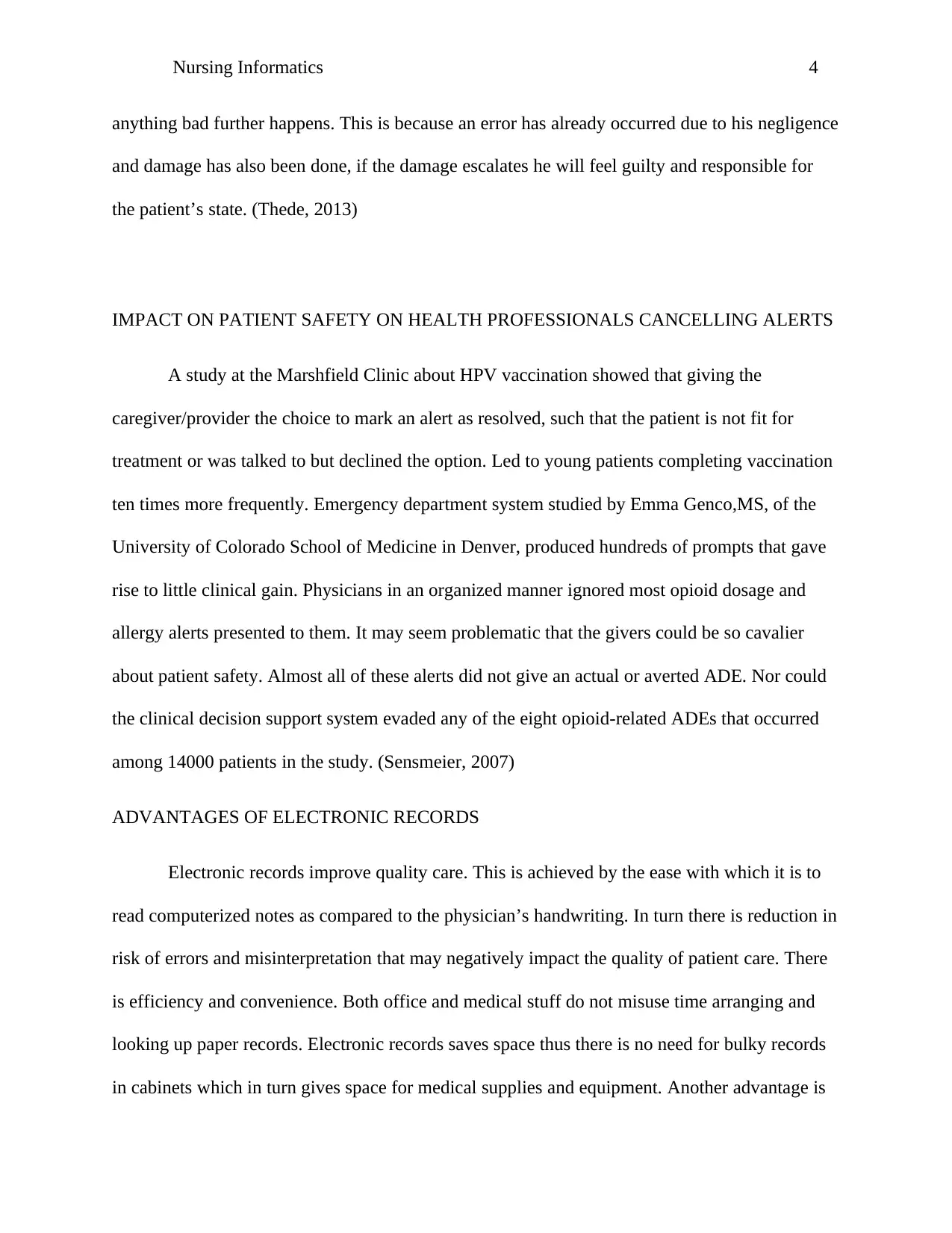
Nursing Informatics 4
anything bad further happens. This is because an error has already occurred due to his negligence
and damage has also been done, if the damage escalates he will feel guilty and responsible for
the patient’s state. (Thede, 2013)
IMPACT ON PATIENT SAFETY ON HEALTH PROFESSIONALS CANCELLING ALERTS
A study at the Marshfield Clinic about HPV vaccination showed that giving the
caregiver/provider the choice to mark an alert as resolved, such that the patient is not fit for
treatment or was talked to but declined the option. Led to young patients completing vaccination
ten times more frequently. Emergency department system studied by Emma Genco,MS, of the
University of Colorado School of Medicine in Denver, produced hundreds of prompts that gave
rise to little clinical gain. Physicians in an organized manner ignored most opioid dosage and
allergy alerts presented to them. It may seem problematic that the givers could be so cavalier
about patient safety. Almost all of these alerts did not give an actual or averted ADE. Nor could
the clinical decision support system evaded any of the eight opioid-related ADEs that occurred
among 14000 patients in the study. (Sensmeier, 2007)
ADVANTAGES OF ELECTRONIC RECORDS
Electronic records improve quality care. This is achieved by the ease with which it is to
read computerized notes as compared to the physician’s handwriting. In turn there is reduction in
risk of errors and misinterpretation that may negatively impact the quality of patient care. There
is efficiency and convenience. Both office and medical stuff do not misuse time arranging and
looking up paper records. Electronic records saves space thus there is no need for bulky records
in cabinets which in turn gives space for medical supplies and equipment. Another advantage is
anything bad further happens. This is because an error has already occurred due to his negligence
and damage has also been done, if the damage escalates he will feel guilty and responsible for
the patient’s state. (Thede, 2013)
IMPACT ON PATIENT SAFETY ON HEALTH PROFESSIONALS CANCELLING ALERTS
A study at the Marshfield Clinic about HPV vaccination showed that giving the
caregiver/provider the choice to mark an alert as resolved, such that the patient is not fit for
treatment or was talked to but declined the option. Led to young patients completing vaccination
ten times more frequently. Emergency department system studied by Emma Genco,MS, of the
University of Colorado School of Medicine in Denver, produced hundreds of prompts that gave
rise to little clinical gain. Physicians in an organized manner ignored most opioid dosage and
allergy alerts presented to them. It may seem problematic that the givers could be so cavalier
about patient safety. Almost all of these alerts did not give an actual or averted ADE. Nor could
the clinical decision support system evaded any of the eight opioid-related ADEs that occurred
among 14000 patients in the study. (Sensmeier, 2007)
ADVANTAGES OF ELECTRONIC RECORDS
Electronic records improve quality care. This is achieved by the ease with which it is to
read computerized notes as compared to the physician’s handwriting. In turn there is reduction in
risk of errors and misinterpretation that may negatively impact the quality of patient care. There
is efficiency and convenience. Both office and medical stuff do not misuse time arranging and
looking up paper records. Electronic records saves space thus there is no need for bulky records
in cabinets which in turn gives space for medical supplies and equipment. Another advantage is
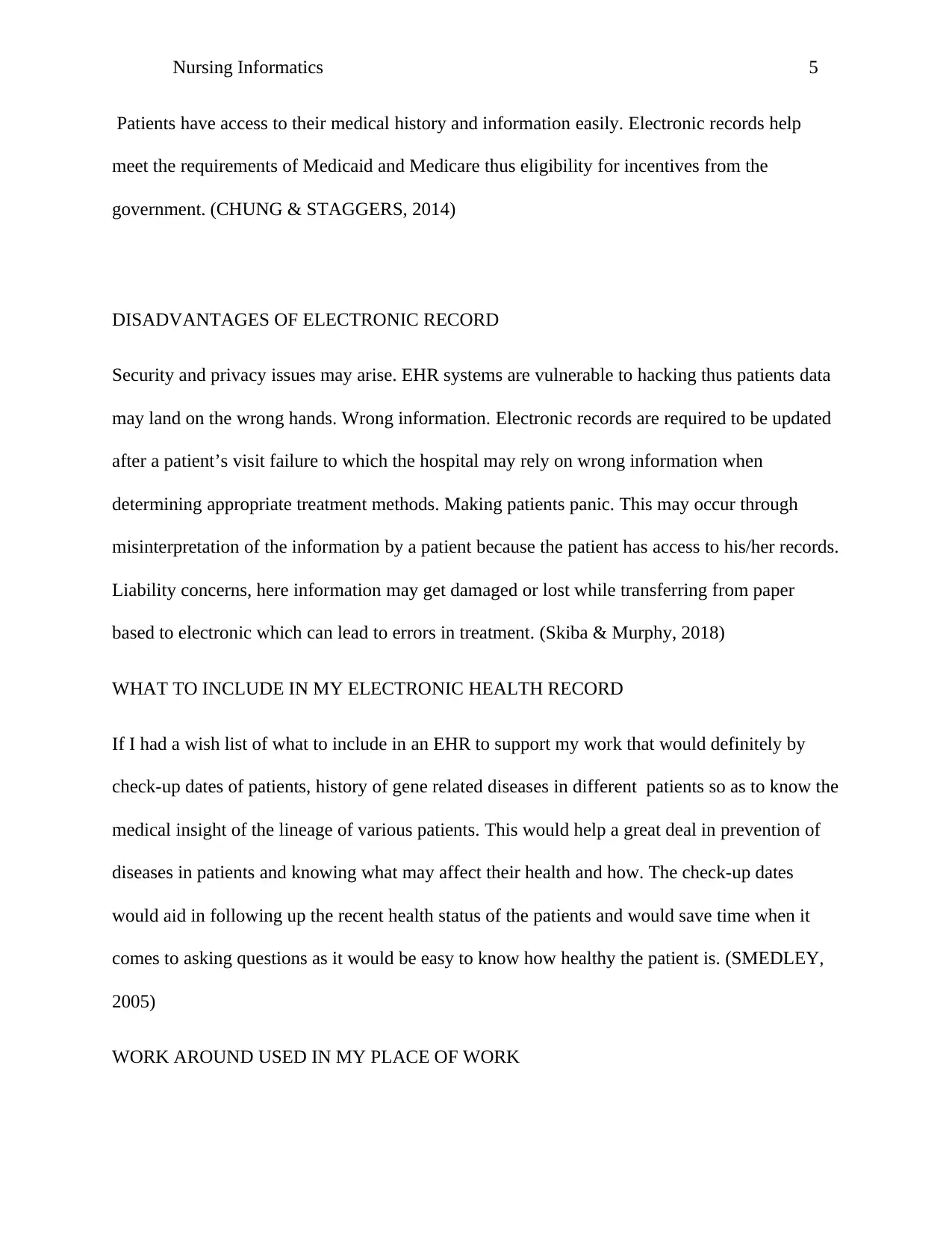
Nursing Informatics 5
Patients have access to their medical history and information easily. Electronic records help
meet the requirements of Medicaid and Medicare thus eligibility for incentives from the
government. (CHUNG & STAGGERS, 2014)
DISADVANTAGES OF ELECTRONIC RECORD
Security and privacy issues may arise. EHR systems are vulnerable to hacking thus patients data
may land on the wrong hands. Wrong information. Electronic records are required to be updated
after a patient’s visit failure to which the hospital may rely on wrong information when
determining appropriate treatment methods. Making patients panic. This may occur through
misinterpretation of the information by a patient because the patient has access to his/her records.
Liability concerns, here information may get damaged or lost while transferring from paper
based to electronic which can lead to errors in treatment. (Skiba & Murphy, 2018)
WHAT TO INCLUDE IN MY ELECTRONIC HEALTH RECORD
If I had a wish list of what to include in an EHR to support my work that would definitely by
check-up dates of patients, history of gene related diseases in different patients so as to know the
medical insight of the lineage of various patients. This would help a great deal in prevention of
diseases in patients and knowing what may affect their health and how. The check-up dates
would aid in following up the recent health status of the patients and would save time when it
comes to asking questions as it would be easy to know how healthy the patient is. (SMEDLEY,
2005)
WORK AROUND USED IN MY PLACE OF WORK
Patients have access to their medical history and information easily. Electronic records help
meet the requirements of Medicaid and Medicare thus eligibility for incentives from the
government. (CHUNG & STAGGERS, 2014)
DISADVANTAGES OF ELECTRONIC RECORD
Security and privacy issues may arise. EHR systems are vulnerable to hacking thus patients data
may land on the wrong hands. Wrong information. Electronic records are required to be updated
after a patient’s visit failure to which the hospital may rely on wrong information when
determining appropriate treatment methods. Making patients panic. This may occur through
misinterpretation of the information by a patient because the patient has access to his/her records.
Liability concerns, here information may get damaged or lost while transferring from paper
based to electronic which can lead to errors in treatment. (Skiba & Murphy, 2018)
WHAT TO INCLUDE IN MY ELECTRONIC HEALTH RECORD
If I had a wish list of what to include in an EHR to support my work that would definitely by
check-up dates of patients, history of gene related diseases in different patients so as to know the
medical insight of the lineage of various patients. This would help a great deal in prevention of
diseases in patients and knowing what may affect their health and how. The check-up dates
would aid in following up the recent health status of the patients and would save time when it
comes to asking questions as it would be easy to know how healthy the patient is. (SMEDLEY,
2005)
WORK AROUND USED IN MY PLACE OF WORK
⊘ This is a preview!⊘
Do you want full access?
Subscribe today to unlock all pages.

Trusted by 1+ million students worldwide
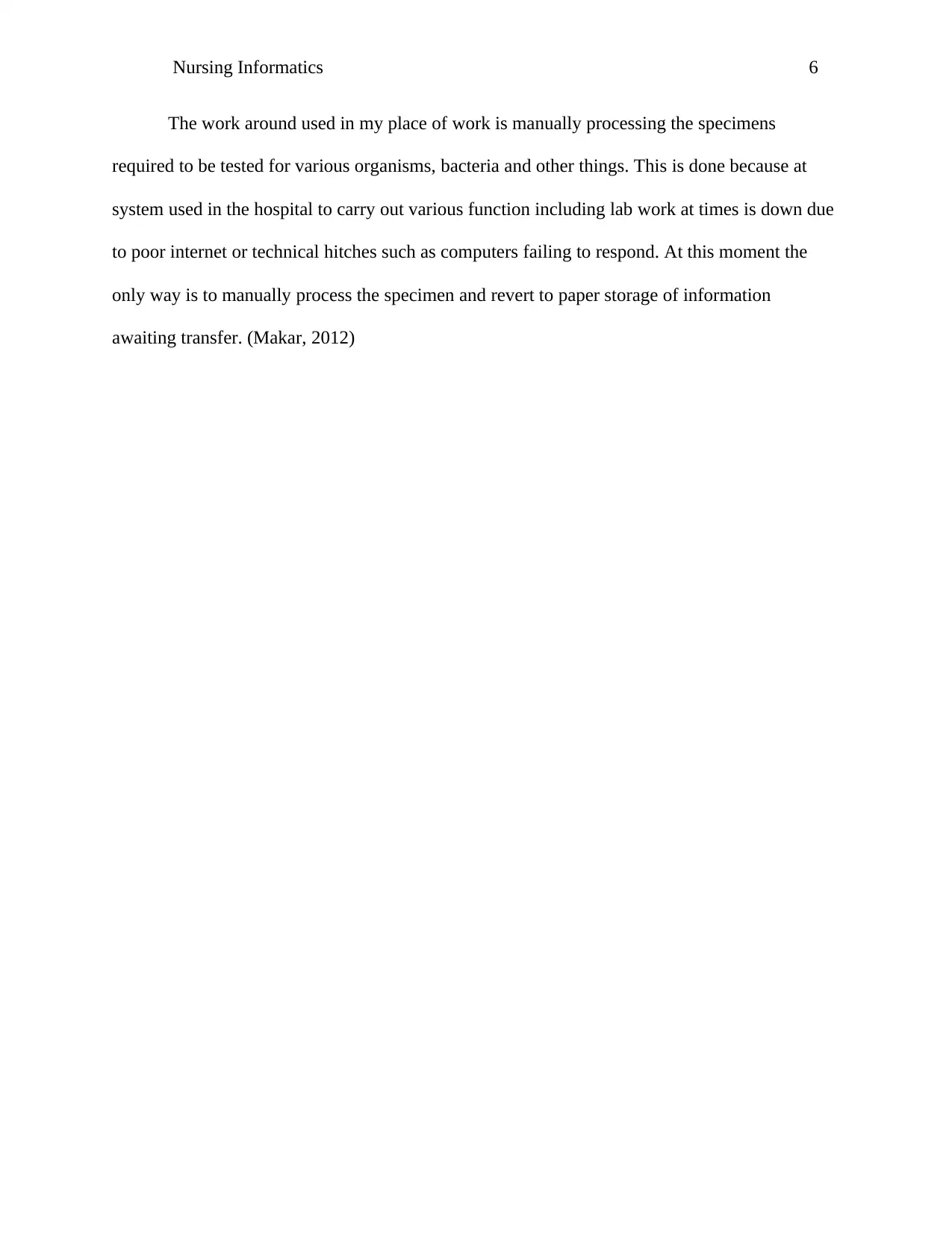
Nursing Informatics 6
The work around used in my place of work is manually processing the specimens
required to be tested for various organisms, bacteria and other things. This is done because at
system used in the hospital to carry out various function including lab work at times is down due
to poor internet or technical hitches such as computers failing to respond. At this moment the
only way is to manually process the specimen and revert to paper storage of information
awaiting transfer. (Makar, 2012)
The work around used in my place of work is manually processing the specimens
required to be tested for various organisms, bacteria and other things. This is done because at
system used in the hospital to carry out various function including lab work at times is down due
to poor internet or technical hitches such as computers failing to respond. At this moment the
only way is to manually process the specimen and revert to paper storage of information
awaiting transfer. (Makar, 2012)
Paraphrase This Document
Need a fresh take? Get an instant paraphrase of this document with our AI Paraphraser
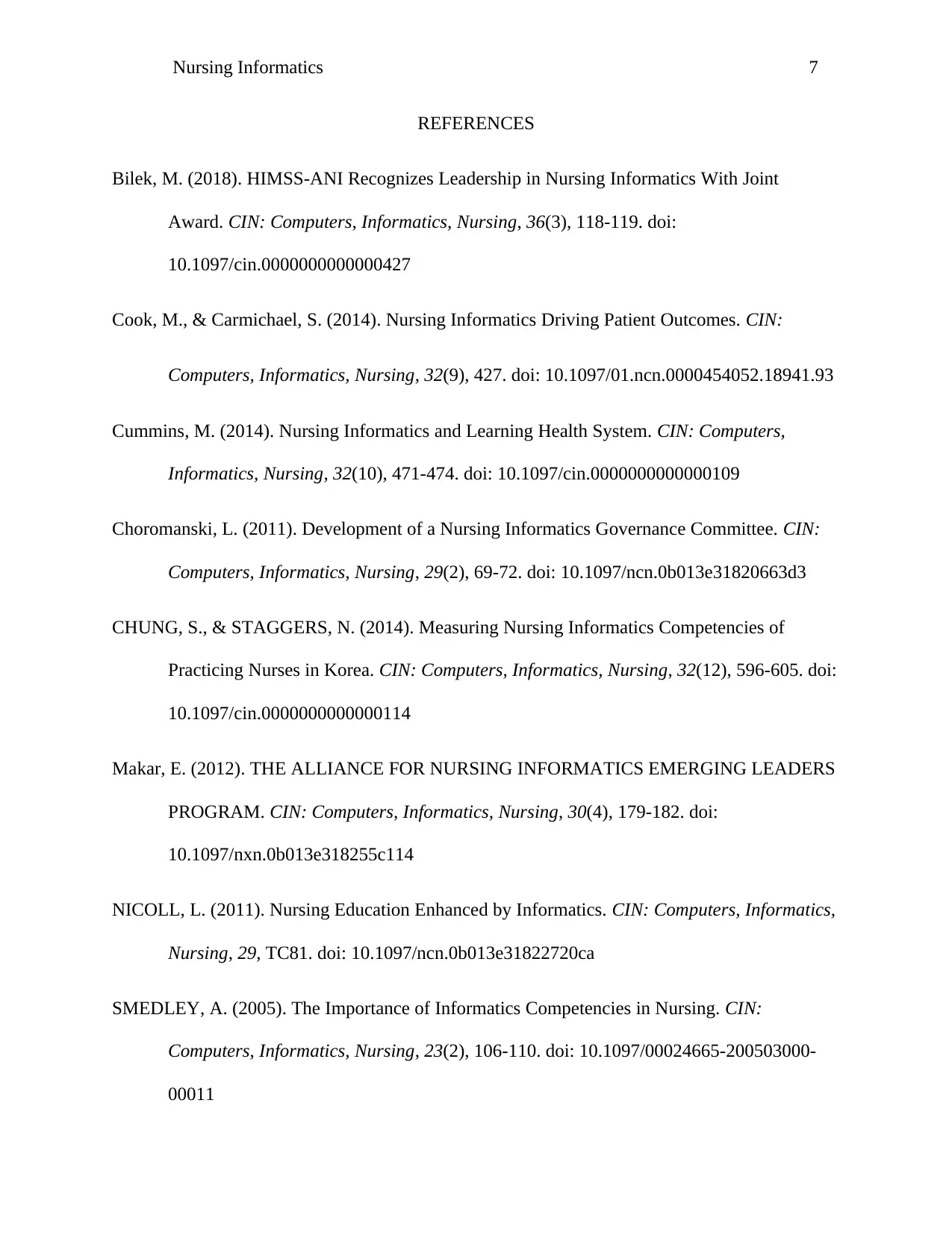
Nursing Informatics 7
REFERENCES
Bilek, M. (2018). HIMSS-ANI Recognizes Leadership in Nursing Informatics With Joint
Award. CIN: Computers, Informatics, Nursing, 36(3), 118-119. doi:
10.1097/cin.0000000000000427
Cook, M., & Carmichael, S. (2014). Nursing Informatics Driving Patient Outcomes. CIN:
Computers, Informatics, Nursing, 32(9), 427. doi: 10.1097/01.ncn.0000454052.18941.93
Cummins, M. (2014). Nursing Informatics and Learning Health System. CIN: Computers,
Informatics, Nursing, 32(10), 471-474. doi: 10.1097/cin.0000000000000109
Choromanski, L. (2011). Development of a Nursing Informatics Governance Committee. CIN:
Computers, Informatics, Nursing, 29(2), 69-72. doi: 10.1097/ncn.0b013e31820663d3
CHUNG, S., & STAGGERS, N. (2014). Measuring Nursing Informatics Competencies of
Practicing Nurses in Korea. CIN: Computers, Informatics, Nursing, 32(12), 596-605. doi:
10.1097/cin.0000000000000114
Makar, E. (2012). THE ALLIANCE FOR NURSING INFORMATICS EMERGING LEADERS
PROGRAM. CIN: Computers, Informatics, Nursing, 30(4), 179-182. doi:
10.1097/nxn.0b013e318255c114
NICOLL, L. (2011). Nursing Education Enhanced by Informatics. CIN: Computers, Informatics,
Nursing, 29, TC81. doi: 10.1097/ncn.0b013e31822720ca
SMEDLEY, A. (2005). The Importance of Informatics Competencies in Nursing. CIN:
Computers, Informatics, Nursing, 23(2), 106-110. doi: 10.1097/00024665-200503000-
00011
REFERENCES
Bilek, M. (2018). HIMSS-ANI Recognizes Leadership in Nursing Informatics With Joint
Award. CIN: Computers, Informatics, Nursing, 36(3), 118-119. doi:
10.1097/cin.0000000000000427
Cook, M., & Carmichael, S. (2014). Nursing Informatics Driving Patient Outcomes. CIN:
Computers, Informatics, Nursing, 32(9), 427. doi: 10.1097/01.ncn.0000454052.18941.93
Cummins, M. (2014). Nursing Informatics and Learning Health System. CIN: Computers,
Informatics, Nursing, 32(10), 471-474. doi: 10.1097/cin.0000000000000109
Choromanski, L. (2011). Development of a Nursing Informatics Governance Committee. CIN:
Computers, Informatics, Nursing, 29(2), 69-72. doi: 10.1097/ncn.0b013e31820663d3
CHUNG, S., & STAGGERS, N. (2014). Measuring Nursing Informatics Competencies of
Practicing Nurses in Korea. CIN: Computers, Informatics, Nursing, 32(12), 596-605. doi:
10.1097/cin.0000000000000114
Makar, E. (2012). THE ALLIANCE FOR NURSING INFORMATICS EMERGING LEADERS
PROGRAM. CIN: Computers, Informatics, Nursing, 30(4), 179-182. doi:
10.1097/nxn.0b013e318255c114
NICOLL, L. (2011). Nursing Education Enhanced by Informatics. CIN: Computers, Informatics,
Nursing, 29, TC81. doi: 10.1097/ncn.0b013e31822720ca
SMEDLEY, A. (2005). The Importance of Informatics Competencies in Nursing. CIN:
Computers, Informatics, Nursing, 23(2), 106-110. doi: 10.1097/00024665-200503000-
00011
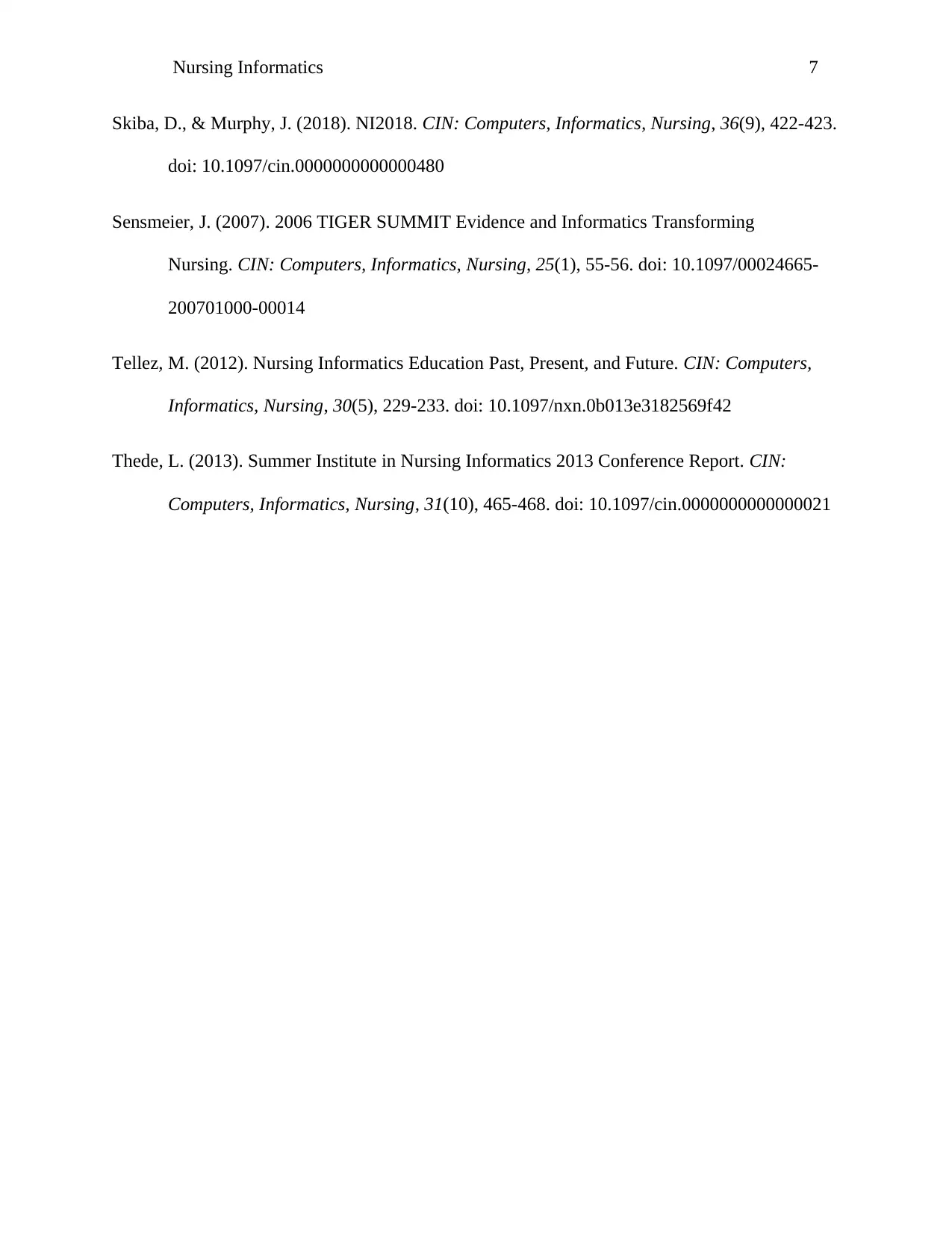
Nursing Informatics 7
Skiba, D., & Murphy, J. (2018). NI2018. CIN: Computers, Informatics, Nursing, 36(9), 422-423.
doi: 10.1097/cin.0000000000000480
Sensmeier, J. (2007). 2006 TIGER SUMMIT Evidence and Informatics Transforming
Nursing. CIN: Computers, Informatics, Nursing, 25(1), 55-56. doi: 10.1097/00024665-
200701000-00014
Tellez, M. (2012). Nursing Informatics Education Past, Present, and Future. CIN: Computers,
Informatics, Nursing, 30(5), 229-233. doi: 10.1097/nxn.0b013e3182569f42
Thede, L. (2013). Summer Institute in Nursing Informatics 2013 Conference Report. CIN:
Computers, Informatics, Nursing, 31(10), 465-468. doi: 10.1097/cin.0000000000000021
Skiba, D., & Murphy, J. (2018). NI2018. CIN: Computers, Informatics, Nursing, 36(9), 422-423.
doi: 10.1097/cin.0000000000000480
Sensmeier, J. (2007). 2006 TIGER SUMMIT Evidence and Informatics Transforming
Nursing. CIN: Computers, Informatics, Nursing, 25(1), 55-56. doi: 10.1097/00024665-
200701000-00014
Tellez, M. (2012). Nursing Informatics Education Past, Present, and Future. CIN: Computers,
Informatics, Nursing, 30(5), 229-233. doi: 10.1097/nxn.0b013e3182569f42
Thede, L. (2013). Summer Institute in Nursing Informatics 2013 Conference Report. CIN:
Computers, Informatics, Nursing, 31(10), 465-468. doi: 10.1097/cin.0000000000000021
⊘ This is a preview!⊘
Do you want full access?
Subscribe today to unlock all pages.

Trusted by 1+ million students worldwide
1 out of 9
Related Documents
Your All-in-One AI-Powered Toolkit for Academic Success.
+13062052269
info@desklib.com
Available 24*7 on WhatsApp / Email
![[object Object]](/_next/static/media/star-bottom.7253800d.svg)
Unlock your academic potential
Copyright © 2020–2025 A2Z Services. All Rights Reserved. Developed and managed by ZUCOL.




